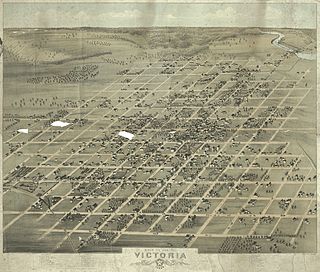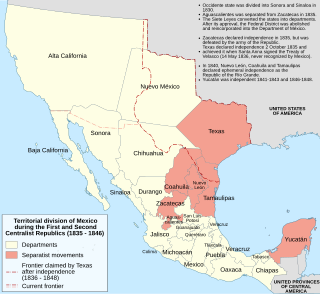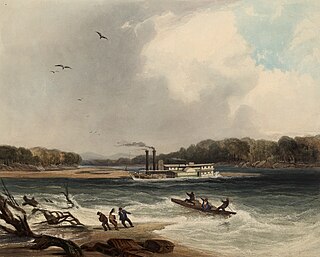 W
WMexican Texas is the historiographical name used to refer to the era of Texan history between 1821 and 1836, when it was part of Mexico. Mexico gained independence in 1821 after winning its war against Spain, which began in 1810. Initially, Mexican Texas operated similarly to Spanish Texas. Ratification of the 1824 Constitution of Mexico created a federal structure, and the province of Tejas was joined with the province of Coahuila to form the state of Coahuila y Tejas.
 W
WCoahuila y Tejas was one of the constituent states of the newly established United Mexican States under its 1824 Constitution.
 W
WThe Battle of the Alamo was a crucial conflict of the Texas Revolution. In 1835, colonists from the United States joined with Tejanos in putting up armed resistance to the centralization of the Mexican government. President Antonio López de Santa Anna and the government in Mexico City believed the United States had instigated the insurrection with a goal of annexing Texas.
 W
WThe Anahuac Disturbances were uprisings of settlers in and around Anahuac, Texas, in 1832 and 1835 which helped to precipitate the Texas Revolution. This eventually led to the territory's secession from Mexico and the founding of the Republic of Texas. Anahuac was located on the east side of the Trinity River near the north shore of Galveston Bay, which placed it astride the trade route between Texas and Louisiana, and from there to the rest of the United States. In new attempts to curtail smuggling and enforce customs tariffs from the coastal settlements, Mexico placed a garrison there after 1830. American settlers came into conflict with Mexican military officers, and rose up against them. They increased political activity and residents of numerous communities declared support for the federalists, who were revolting against the Mexican Government.
 W
WThe Comanche–Mexico Wars was the Mexican theater of the Comanche Wars, a series of conflicts from 1821 to 1870. There were large-scale raids into northern Mexico by the Comanche and their Kiowa and Kiowa Apache allies, which left thousands of people dead. The Comanche raids were sparked by the declining military capability of Mexico during the turbulent years after it gained independence in 1821, as well as a large and growing market in the United States for stolen Mexican horses and cattle.
 W
WDe León's Colony was established in 1824 in northern Coahuila y Tejas state of the First Mexican Republic, by empresario Martín De León. It was the only ethnically Mexican colony founded during the Mexican period (1824-1835) that is located within the present-day U.S. state of Texas.
 W
WThe Lake Creek Settlement was a settlement in Stephen F. Austin's Second Colony located in Mexican Texas and later the Republic of Texas. The Lake Creek Settlement was located between the West Fork of the San Jacinto River (Texas) and the stream known as Lake Creek in what is today western Montgomery County, Texas. In July 1837, the town of Montgomery, Texas was founded in the middle of the Lake Creek Settlement.
 W
WAn empresario [em.pɾe.ˈsaɾ.jo] was a person who had been granted the right to settle on land in exchange for recruiting and taking responsibility for settling the eastern areas of Coahuila y Texas in the early nineteenth century. The word in Spanish for entrepreneur is emprendedor.
 W
WThe Fredonian Rebellion was the first attempt by Anglo settlers in Texas to secede from Mexico. The settlers, led by Empresario Haden Edwards, declared independence from Mexican Texas and created the Republic of Fredonia near Nacogdoches. The short-lived republic encompassed the land the Mexican government had granted to Edwards in 1825 and included areas that had been previously settled. Edwards's actions soon alienated the established residents, and the increasing hostilities between them and settlers recruited by Edwards led Victor Blanco of the Mexican government to revoke Edwards's contract.
 W
WThe Fredonian Rebellion was the first attempt by Anglo settlers in Texas to secede from Mexico. The settlers, led by Empresario Haden Edwards, declared independence from Mexican Texas and created the Republic of Fredonia near Nacogdoches. The short-lived republic encompassed the land the Mexican government had granted to Edwards in 1825 and included areas that had been previously settled. Edwards's actions soon alienated the established residents, and the increasing hostilities between them and settlers recruited by Edwards led Victor Blanco of the Mexican government to revoke Edwards's contract.
 W
WThe Goliad Declaration of Independence was signed on December 20, 1835 at Presidio La Bahía in Mexican Texas.
 W
WThe Long Expedition was an 1819 attempt to take control of Spanish Texas by filibusters. It was led by James Long and successfully established a small independent government, known as the Republic of Texas. The expedition crumbled later in the year, as Spanish troops drove the invaders out. Long returned to Texas in 1820 and attempted to reestablish his control. In October 1821, Long was defeated by Spanish troops, captured and sent to Mexico City where he was killed by a guard.
 W
WMoore's Fort is a twin dogtrot type blockhouse in Round Top, Texas. Built by John Henry Moore in 1828, it is the oldest building in Fayette County. It was originally located where La Grange is today, as a shelter for settlers from Comanche raids. Later it was moved to Round Top. A historical marker sits at the original location in La Grange.
 W
WNuevo Santander was a region of the Viceroyalty of New Spain, covering the modern Mexican state of Tamaulipas and extending into modern-day southern Texas in the United States. A history of Texas, commissioned by the U.S. government's Federal Writers' Project in 1934, noted that "The borders of New Santander did not stop at the Rio Bravo" ; and added that the borders "went north to the Nueces, near Corpus Christi, then west and north to the Medina, then south again on a line along Laredo to the eastern slopes of the Sierra Madres, deep in Mexico."
 W
WThe Old San Antonio Road was a historic roadway located in the U.S. states of Texas and Louisiana. Parts of it were based on traditional Native American trails. Its Texas terminus was about 35 miles (56 km) southeast of Eagle Pass at the Rio Grande in Maverick County, and its northern terminus was at Natchitoches, Louisiana. The road continued from Texas through Monclova to Mexico City.
 W
WThe Republic of the Rio Grande was an independent nation that insurgents fighting against the Centralist Republic of Mexico sought to establish in northern Mexico. The Republic of the Rio Grande was just one of a series of independence movements in Mexico under the unitary government dominated by Santa Anna, including the Republic of Texas, the Republic of Zacatecas, and the Republic of Yucatán. The rebellion lasted from 17 January to 6 November 1840.
 W
WThe flag of the Republic of the Rio Grande was used in 1840, during 283 days from January 17 to November 6, as long as the republic existed. This country was formed by the northeastern Mexican states of Coahuila, Nuevo León, and Tamaulipas. The flag was no longer used following the defeat of the Republic of the Rio Grande by Mexican troops.
 W
WRobertson's Colony was an empresario colonization effort during the Mexican Texas period. It is named after Sterling C. Robertson, but had previously been known by other names. It has also been referred to as the Nashville Colony, after the Tennessee city where the effort originated, the Texas Association, the Upper Colony, and Leftwich's Grant, named after early colonizer Robert Leftwich. The eventual contract spread over an area that includes all or part of thirty present-day counties in Texas.
 W
WThe Runaway Scrape events took place mainly between September 1835 and April 1836 and were the evacuations by Texas residents fleeing the Mexican Army of Operations during the Texas Revolution, from the Battle of the Alamo through the decisive Battle of San Jacinto. The ad interim government of the new Republic of Texas and much of the civilian population fled eastward ahead of the Mexican forces. The conflict arose after Antonio López de Santa Anna abrogated the 1824 Constitution of Mexico and established martial law in Coahuila y Tejas. The Texians resisted and declared their independence. It was Sam Houston's responsibility, as the appointed commander-in-chief of the Provisional Army of Texas, to recruit and train a military force to defend the population against troops led by Santa Anna.
 W
WThe San Felipe incident was the first naval battle fought between Mexican and rebel forces during the Texas Revolution. On September 1, 1835, the American owned merchant ships San Felipe and Laura were crewed by Texans when they encountered the Mexican Navy warship Correo de Mejico and captured her after a bloody exchange of cannon fire. The battle occurred off the coast of Texas near Brazoria and is remembered for having involved Stephen F. Austin who was on board the San Felipe.
 W
WSarahville de Viesca or Fort Milam or Bucksnort is a ghost town in Falls County, Texas, United States. The settlement was established in 1834 by Sterling C. Robertson and named for his mother Mrs. Sarah Robertson and Agustín Viesca, the Mexican governor of Coahuila y Tejas. The site was located at the falls of the Brazos River, where the river formerly dropped 10 feet (3 m) and where a well-used ford was located. The town was temporarily deserted in 1836 during the Runaway Scrape and permanently abandoned soon afterward because of native American raids. Fort Milam was built on the west-bank site but abandoned a few years later in favor of the town of Bucksnort which occupied the east bank. Bucksnort vanished when the nearby town of Marlin was founded. There is a county park and historical marker located where Farm to Market Road 712 crosses the Brazos south of Marlin.
 W
WTelegraph and Texas Register (1835–1877) was the second permanent newspaper in Texas. Originally conceived as the Telegraph and Texas Planter, the newspaper was renamed shortly before it began publication, to reflect its new mission to be "a faithful register of passing events". Owners Gail Borden, John Pettit Borden, and Joseph Baker founded the paper in San Felipe de Austin, a community long at the center of Texas politics. The first issue was printed on October 10, 1835, days after the outbreak of the Texas Revolution. The Telegraph continued to report news of the war and the formation of the new Republic of Texas through the end of March 1836. As the Mexican Army approached the colonies in eastern Texas, most residents fled eastward. The owners of the Telegraph and their printing press evacuated on March 30 with the rear guard of the Texian Army. The press was quickly reestablished in Harrisburg. On April 14, Mexican soldiers captured the printing press and threw it into Buffalo Bayou.
 W
WThe Texas Revolution was a rebellion of colonists from the United States and Tejanos in putting up armed resistance to the centralist government of Mexico. While the uprising was part of a larger one, the Mexican Federalist War, that included other provinces opposed to the regime of President Antonio López de Santa Anna, the Mexican government believed the United States had instigated the Texas insurrection with the goal of annexation. The Mexican Congress passed the Tornel Decree, declaring that any foreigners fighting against Mexican troops "will be deemed pirates and dealt with as such, being citizens of no nation presently at war with the Republic and fighting under no recognized flag". Only the province of Texas succeeded in breaking with Mexico, establishing the Republic of Texas, and eventually being annexed by the United States.
The Battle of Velasco, fought June 25-26, 1832, was the first true military conflict between Mexico and Texians in the Texas Revolution. It began when Texian Militia attacked Fort Velasco, located in what was then Velasco and what is now the city of Surfside Beach. The Mexican commander during the conflict, Domingo de Ugartechea, tried to stop the Texians, under John Austin, from transporting a cannon down the Brazos River to attack the city of Anahuac. The Texian Militia eventually prevailed over the Mexicans. Ugartechea surrendered after a two-day battle, once he realized he would not be receiving reinforcements, and his soldiers had run out.
 W
WThe steamboat Yellowstone was a side wheeler steamboat built in Louisville, Kentucky, for the American Fur Company for service on the Missouri River. By design, the Yellowstone was the first powered boat to reach above Council Bluffs, Iowa, on the Missouri River achieving, on her maiden voyage, Fort Tecumseh, South Dakota, on June 19, 1831. The Yellowstone also played an important role in the Texas Revolution of 1836, crossing the Texas Army under Sam Houston over the swollen Brazos River ahead of Santa Anna's pursuing Mexican Army.
 W
WThe Yturri–Edmunds Historic Site is a historic site in San Antonio, Texas. The house is listed on the National Register of Historic Places listings in Bexar County, Texas. The homestead and mill were designated a Recorded Texas Historic Landmark in 1966.